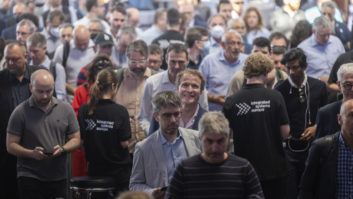“I loved being the CEO of InfoComm, but the job and opportunity of being the CEO of AVIXA is so much more exciting,” beamed David (Dave) Labuskes back in September 2018, the sunlight and green glow of London’s Hyde Park gleaming from the window as we sat down. “It’s been a really busy year,” he added, smiling. “What day is it, again?”
He was joking on the latter, but he’d have been forgiven if he wasn’t, such are the business needs and demands required under his leadership. For Labuskes’ body clock had certainly taken a battering, with business visits to China, Australia, India, Mexico all being held in the preceding days and weeks ahead of our meeting. Indeed, just that morning Labuskes had awoken in Munich, having held a meeting with ISE MD Mike Blackman, before jetting to London.
“I’ve been in so many time-zones in the past six weeks, I’m not jet lagged, just a mess,” he joked, more than enjoying his espresso. “There’s a side of it that’s a blessing and a side that’s challenging.”
However, a challenge is something neither he nor his AVIXA team are afraid of embracing. Indeed, the past 12 months have, he confesses, been some of the most challenging of his six-year tenure at the organisation, but one he struggles to contain his excitement in driving forward.
For the day of our meeting marked the one-year anniversary since Labuskes stood on stage announcing that InfoComm International – a brand that had existed since 2005, was being rebranded to AVIXA.
“It was the most nerve-wracking day of my career,” he reminisced
Thankfully, 12-months on, his anxiety has proved to be unfounded, with AVIXA continuing to go from strength to strength – adding close to 3,000 members during this period – and its impact on the market being felt on a greater and broader scale.
Building blocks
So what’s changed? The switch (as Labuskes made explicitly clear) was not a vanity project simply investing in a new fancy logo and having a new coat of paint on its office walls. The business and its role was changing. The new name, like the organisation, had to represent, as he explained back in 2017, “something more” for the industry and the members it serves across 80 different countries.
“Lots of companies rebrand to try to create an illusion of investing in change,” said Labuskes. “But in truth, it’s none of that, simply satisfying someone’s ego in having a new logo. I refuse to be part of that approach.”
Adding value and experience
AVIXA – or the ‘Audiovisual and Integrated Experience Association’ to give its full title – wanted, almost felt obligated, take a greater responsibility for supporting and spearheading the growth of the AV industry.
And by industry we’re talking across all levels; manufacturers, systems integrators, dealers and distributors, consultants, programmers, rental and staging companies, technology managers, IT professionals, content producers, multimedia professionals and, key to its strategy, end users.
Investment in AV has never been higher as businesses increasingly turn to technology to help enhance the experience within their specific vertical, whether it be for staff, customers or both.
The opportunities therefore in AV have equally never been greater. According to AVIXA’s Industry Outlook and Trends Analysis (IOTA), the AV industry will be worth approximately $180 billion by the close of this year (2018) and expected to rise to $230 billion by 2023.
Whilst AVIXA – an entirely not for profit organisation – is not directly involved in the buying and selling of products, its role is to help provide the industry (collectively and individually) with the market intelligence, insight and training it requires to help ensure its potential is achieved and felt across the planet.
“We see ourselves as providing two purposes,” explained Labuskes. “One is to be the trusted hub of the professional community and two, to be a catalyst for market growth. We as an industry association can’t grow the market, it’s the participants in the supply chain and the buyers who will grow the market, so we’re very clearly focussed on being a catalyst for that reaction to take place, but not participating in the reaction.”
Experience is everything
As mentioned, one key to AVIXA’s refreshed strategy is centred around its focus on supporting, building relationships and communicating with the end user market (decisions makers) to help them to become informed and understand the benefits surrounding AV.
“Together, we can change the way people experience the world,” said Labuskes, echoing the company’s slogan displayed on many of its marketing materials. It sounds a bit PR, but the sentiment is undeniably accurate. “When you think of experience, it normally involves some sort of AV.”
To support this, AVIXA has been investing heavily (time and resource) in conducting significant research on specific vertical markets to produce detailed analysis reports, case studies, white papers and so on, highlighting how AV is being deployed and the results it’s helping comparable businesses achieve.
Focus areas to date since relaunching as AVIXA have looked at AV in financial services, higher education, sports entertainment, hospitality, retail and transportation – all of which are available through its website. The focus for 2019 has not yet been announced.
“It’s a big world and we could easily spend $100m on this effort every year in the US intelligently,” said Labuskes. “We don’t have $100m, so we’ve had to be very specific in our targets and choosing which verticals.
“When you talk about an integrated experience for a hotel or a brand manager in a retail chain, or a sports entertainment venue, when you’re talking fan experience, shopper experience, guest experience, retail entertainment – you’re engaging with them in an area that’s critical to their success and their future.”
Leading this drive is Sean Wargo, who was brought in at the time of the rebrand and serves as senior director, market intelligence.
Driving engagement
Sitting beside Labuskes, Wargo explained that the research provides AVIXA (and by extension the whole industry) with a 360 degrees view of a specific vertical.
“Our role is being able to provide valuable content to our members. Content, such as a research report on how technology is serving a particular vertical market, or the challenges it’s facing, a white paper case study, videos highlighting some of the opportunities in these places,” explained Wargo.
Extending upon that, AVIXA is able to gain valuable insight from the retailers themselves, helping to understand their needs, their challenges and their drivers – information that can potentially be used to help form future products and solutions.
“On one hand, it’s teaching businesses about ways they can improve their business through AV,” notes Labuskes. “On the other, it’s helping the industry ensure it’s able to fulfil those expectations and desires from the customer. Even influencing future product roadmaps.”
But it’s not all through downloadable or digital content. AVIXA is also now taking a more active approach in communicating with the market – adopting a more consultative approach by putting itself directly in front of end users, speaking in a non-technical language about AV, either on a one-to-one level, or through its own specially organised events or guest speaking at others to help the market better understand the opportunities that are available to them.
“We highlight and demonstrate the possibilities that AV can provide,” said Wargo. “That’s a starting point for a conversation, so there can be a hand off. We would never say ‘this is what you need to deploy from an AVIXA stand point’. We’d say ‘this is what has been done as an example’ and that they can then talk to a true integrator and installer and go from there.”
Labuskes adds: “I’m not standing at the front saying here’s the value of AV. We’re creating panels of, say, practitioners who have invested in AV and having those people tell their story. That’s enormously valuable and much more engaging for the end user. InfoComm was and remains a fantastic brand for our shows and we will continue to invest in those, but it wasn’t an engaging brand for, say, a CMO of a hotel brand. When I talk about AV integrated experiences and emphasise that we’re a not for profit organisation and we’re not trying to sell them something, immediately I have a more receptive audience.”
Vertical approach
Educating integrators on new trends and demands being seen in the market is also crucial to ensure they’re well equipped to handle (or offer recommendations) the demands being asked of them. This can be achieved not only through insight, but also through accredited and certified CTS training courses provided by AVIXA – certification that breeds expertise but also trust. Training typically covers installation, design, technology management, live events, networking and technology, project management and business development.
Wargo adds: “The worst thing that could happen is you get someone (a business owner) incredibly excited to the point they’re going to change their business model, create what they believe will create an exceptional experience and kick all their competitors to the kerb – only their supply chain channel doesn’t deliver effectively. That would be a disaster. So, we feel a sense of obligation to assist our professionals in the community to not only understand the outcomes that are needed, but then to have the knowledge, the education, the certifications and the reliance on industry best practices and standards to actually be able to deliver on the promise.”
Geographic expansion
Another key push for AVIXA in 2018 and going into the new year and beyond, is its geographical coverage and support to wider markets.
With AVIXA’s origins in the US, the focus for its work (research, reports etc) has primarily been more localised, with a smaller focus in the EMEA and Europe. But that’s changing.
Labuskes revealed that he’s been in deep discussions around investment to help further enhance its presence and expand its relevance for markets outside of the US.
He revealed in the past year, AVIXA has added five members of staff (taking headcount above 160), with a growing number (over 10) located internationally, building closer ties and understanding of the local market place.
Today, AVIXA hosts events all around the world, spanning Asia, Europe, Latin America, Middle East and Africa, Oceania, the US and Canada.
One of the fastest growing areas for AV investment is coming from EMEA and ASIA regions. Appetite from the industry in those regions to attend its show has certainly been strong. For example, AVIXA has recently (September) hosted its first InfoComm trade show in Chengdu (Western China), which saw attendance numbers hit 8,000, smashing its original 3,000 expectation. AVIXA will be continuing to develop activities, launching InfoComm Southeast Asia in Bangkok in May 2019. Labuskes also revealed he had recently returned from the sixth edition of InfoComm India, which had seen a 29 per cent rise in attendees, topping close to 10,000 for the first time.
“The industry is reaching an inflection point in that region [India],” said Labuskes. “They’re really moving from start up to true commercial AV professionals and we’re helping them along their journey through standards and research. We need to continue to expand our focus on the emerging and developing and rapidly growing markets in order to be a true global industry. The numbers we’re seeing are hugely encouraging.
“Most of the consumers, the large buyers of AV, are global organisations,” he continued, “So, if you’re doing the HQ for an organisation in London, they may have an office in New York, Sydney, Delhi and so on. They will want to replicate the functionality they have for their staff in all their locations. In order to do that, we have to develop and reinforce the channel in all those areas.”
Lost in translation
Expanding upon this further, another major investment from AVIXA is in ensuring that regional translations for its reports are available
Labuskes revealed that “hundreds of thousands” of dollars will be spent next year (2019) to create the mechanism to dynamically translate content that’s being produced. All content is provided in English, with a significant amount of translation into German, Spanish and Portuguese, but more needs to be done.
“We talk wonderfully about all the white papers we produce,” said Labuskes. “We’re producing them in English, which is relevant for a fairly broad share of the global market but is completely irrelevant to many of those in China and is largely irrelevant in places like Chile, Peru and Mexico. Many people who can learn the most from AVIXA from an education perspective, don’t speak English.”
But it’s not simply a case of translating existing text, with regional variations crucial in order to maximise value.
Wargo continued the discussion on the topic. “Translation helps get you exposure to broad themes, but a white paper needs to be localised. If you need to give examples that are pertinent to that market, that’s a much bigger and longer range challenge. At the very least, having content available that’s talking about the bigger picture and providing training material to get started is a first step, but expanding on that is important.”
Labuskes concluded: “We’ve achieved a lot in our first year, but this is an ever-evolving journey. We were 10 per cent along the journey when we announced the new brand, we’re probably 25-30 per cent along the journey a year on. I am so excited about our future.”







